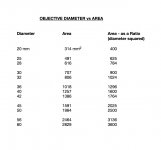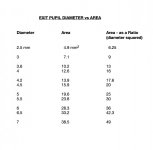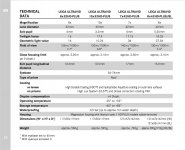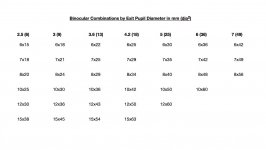John A Roberts
Well-known member

Let me preface this by saying that I’m sure that many others also think about objectives and exit pupils in the same way as described below
However, as I’ve not seen a clear statement of the ideas elsewhere, this may provide an additional perspective for some
- - - -
As we’re all aware the objective diameter is one of the two basic numbers used to describe a binocular e.g. 8x32
And even if we don’t know anything more about a given model, the objective diameter:
- in combination with the magnification, indicates the exit pupil size (again as a diameter), and
- gives some general idea of the relative bulk and weight of a model, compared to those with larger or smaller objectives
However what’s generally under appreciated, is that a small change in objective diameter - and even more so, a small change in exit pupil diameter
- may have a large effect on the area of the objective or exit pupil - and therefore on performance
i.e. the relationship of the diameter of a circle to its area is not at all intuitively obvious
Some examples in relation to objective diameter:
- with small binoculars, increasing the diameter from 20 to 25 mm results in over a 50% increase in area, and
- at the other extreme, an increase in diameter from 50 to 56 mm results in a 25% increase an area
And in relation to exit pupil diameter:
- increasing the diameter from 2.5 to 3 mm results in a 45% increase in area, and
- from 3 to 3.6 mm results in a 43% increase in area
It should be especially noted, that when considering binoculars with small exit pupils:
- at higher levels of illumination, the pupil of the human eye responds gradually to decreasing light intensity,
- so a small increase in the size of a binocular’s exit pupil, will often extend its usability to a much wider range of lighting levels
To make the relationships easy to understand I’ve attached 2 tables:
- one showing objective diameter vs area
- and the other exit pupil diameter vs area
In each table, each increase in the cross-sectional area is by roughly 50% - adjusting for the practicality of using common objective and exit pupil diameters
Calculating the Area of a Circle - Simplified
While the standard formula used to calculate the area of a circle 'Pi r squared' produces an exact result, for most it requires the use of a calculator
However, there is a much easier way to calculate the relative area of a circle - just square the diameter
That is, eliminate Pi as it’s a constant, and don’t bother to divide the diameter before squaring it
This method is included in the above two tables (the right hand column), and has the added advantage of producing more rounded numbers which make comparisons somewhat easier
In relation to exit pupil size, Leica uses this simplified calculation in it’s manuals where it’s called Geometric Light Value, see the attached image
Another Quick Approach
When comparing diameter to area:
- a 22% increase in diameter increases the area by half
- a 40% increase doubles the area *
- a 75% increase triples the area, and
- a 100% increase quadruples the area
* This is also clearly expressed in the classic aperture sequence used in photography: f/1; /1.4; /2; /2.8; /4, /5.6; /8; . . . ; /64
As this is an inverse sequence, with each increase in the number the area of the aperture halves
However, the numerical relationships hold. So changing the exit pupil size from 2.8 to 4 mm - or the objective size from 28 to 40 mm - will produce a doubling of the area
Binocular Configurations - Based on Exit Pupil Area
I’ve also attached a table showing binocular configurations as sorted by exit pupil size, where again at each step there is a roughly 50% increase in exit pupil area
The table makes clear the triangular relationship between magnification, objective size and exit pupil size
And it also demonstrates that exit pupil area is a more useful measure of size than diameter
To use the table to select a binocular, one can:
- look down a column for a given exit pupil size, and decide what combination of magnification and objective is optimal
- look across a row for a given magnification, and decide what combination of exit pupil and objective is optimal, or
- look diagonally along a given objective size, and decide what combination of exit pupil and magnification is optimal
So hopefully a useful additional perspective for some
John
However, as I’ve not seen a clear statement of the ideas elsewhere, this may provide an additional perspective for some
- - - -
As we’re all aware the objective diameter is one of the two basic numbers used to describe a binocular e.g. 8x32
And even if we don’t know anything more about a given model, the objective diameter:
- in combination with the magnification, indicates the exit pupil size (again as a diameter), and
- gives some general idea of the relative bulk and weight of a model, compared to those with larger or smaller objectives
However what’s generally under appreciated, is that a small change in objective diameter - and even more so, a small change in exit pupil diameter
- may have a large effect on the area of the objective or exit pupil - and therefore on performance
i.e. the relationship of the diameter of a circle to its area is not at all intuitively obvious
Some examples in relation to objective diameter:
- with small binoculars, increasing the diameter from 20 to 25 mm results in over a 50% increase in area, and
- at the other extreme, an increase in diameter from 50 to 56 mm results in a 25% increase an area
And in relation to exit pupil diameter:
- increasing the diameter from 2.5 to 3 mm results in a 45% increase in area, and
- from 3 to 3.6 mm results in a 43% increase in area
It should be especially noted, that when considering binoculars with small exit pupils:
- at higher levels of illumination, the pupil of the human eye responds gradually to decreasing light intensity,
- so a small increase in the size of a binocular’s exit pupil, will often extend its usability to a much wider range of lighting levels
To make the relationships easy to understand I’ve attached 2 tables:
- one showing objective diameter vs area
- and the other exit pupil diameter vs area
In each table, each increase in the cross-sectional area is by roughly 50% - adjusting for the practicality of using common objective and exit pupil diameters
Calculating the Area of a Circle - Simplified
While the standard formula used to calculate the area of a circle 'Pi r squared' produces an exact result, for most it requires the use of a calculator
However, there is a much easier way to calculate the relative area of a circle - just square the diameter
That is, eliminate Pi as it’s a constant, and don’t bother to divide the diameter before squaring it
This method is included in the above two tables (the right hand column), and has the added advantage of producing more rounded numbers which make comparisons somewhat easier
In relation to exit pupil size, Leica uses this simplified calculation in it’s manuals where it’s called Geometric Light Value, see the attached image
Another Quick Approach
When comparing diameter to area:
- a 22% increase in diameter increases the area by half
- a 40% increase doubles the area *
- a 75% increase triples the area, and
- a 100% increase quadruples the area
* This is also clearly expressed in the classic aperture sequence used in photography: f/1; /1.4; /2; /2.8; /4, /5.6; /8; . . . ; /64
As this is an inverse sequence, with each increase in the number the area of the aperture halves
However, the numerical relationships hold. So changing the exit pupil size from 2.8 to 4 mm - or the objective size from 28 to 40 mm - will produce a doubling of the area
Binocular Configurations - Based on Exit Pupil Area
I’ve also attached a table showing binocular configurations as sorted by exit pupil size, where again at each step there is a roughly 50% increase in exit pupil area
The table makes clear the triangular relationship between magnification, objective size and exit pupil size
And it also demonstrates that exit pupil area is a more useful measure of size than diameter
To use the table to select a binocular, one can:
- look down a column for a given exit pupil size, and decide what combination of magnification and objective is optimal
- look across a row for a given magnification, and decide what combination of exit pupil and objective is optimal, or
- look diagonally along a given objective size, and decide what combination of exit pupil and magnification is optimal
So hopefully a useful additional perspective for some
John
Attachments
Last edited:









